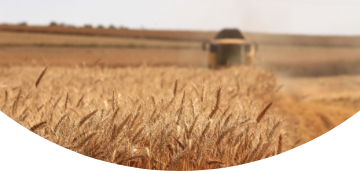Introduction to the Grain Market
Course objectives
To understand initially where the value of grains comes from, the role that Argentina plays in the grain chain, to see how international prices reach the local producer, understanding the roles of the different links in the commercial chain and the most common types of business that are usually handled within the Argentinean market.
Introduction to the Grain Market
Course objectives
To understand initially where the value of grains comes from, the role that Argentina plays in the grain chain, to see how international prices reach the local producer, understanding the roles of the different links in the commercial chain and the most common types of business that are usually handled within the Argentinean market.

Introduction to the Grain Market
Course objectives
To understand initially where the value of grains comes from, the role that Argentina plays in the grain chain, to see how international prices reach the local producer, understanding the roles of the different links in the commercial chain and the most common types of business that are usually handled within the Argentinean market.
Where do I take the course?
Online, from the comfort of your PC or notebook.
Who can do it?
Our collaborators, our clients and students.
How much time will it take me?
The contents are organised in 4 modules of approximately 1 hour each.
What certification will I receive?
At the end of this course you will be able to issue your certificate online.
How much does it cost?
There is no cost, the course is free of charge.
Where do I take the course?
Online, from the comfort of
your PC or notebook.
Who can do it?
Our collaborators, our clients and students.
How much time will it take me?
The contents are organised in 4 modules of approximately 1 hour each.
What certification will I receive?
At the end of this course you will be able to issue your certificate online.
How much does it cost?
There is no cost, the course is free of charge.
Course Modules
Argentina in the World of Agri-Foods.
Objectives of module 1
To learn about Argentina’s participation in the world agri-food trade and how it impacts on the local economy.
Table of contents
- Agrifoods, beyond primary production.
- Argentina’s participation in the cereal trade.
- The outstanding role in the oilseed complex at world level.
- The countryside in numbers, incidence in large aggregates.
- Expansion of the sown area in the last decades.
Course Modules
Argentina in the World of Agri-Foods.
Objectives of module 1
To learn about Argentina’s participation in the world agri-food trade and how it impacts on the local economy.
Table of contents
- Agrifoods, beyond primary production.
- Argentina’s participation in the cereal trade.
- The outstanding role in the oilseed complex at world level.
- The countryside in numbers, incidence in large aggregates.
- Expansion of the sown area in the last decades.
Fundamental Analysis of the Grain Market.
Objectives of module 2
To understand the different economic, political and natural variables, among others, that mainly affect the balance of supply and demand of grains, and therefore, have an impact on their prices.
Índice de conteúdos
- Grain price determinants.
- Fundamental elements.
- Soybean market.
- Corn market.
- Wheat market.
Fundamental Analysis of the Grain Market.
Objectives of module 2
To understand the different economic, political and natural variables, among others, that mainly affect the balance of supply and demand of grains, and therefore, have an impact on their prices.
Table of contents
- Grain price determinants.
- Fundamental elements.
- Soybean market.
- Corn market.
- Wheat market.
Grain Marketing Chain in Argentina.
Objectives of Module 3.
To understand how the money paid by a Chinese consumer for grains reaches the Argentinean producer, passing through the international market, the trading houses and the different local links (exporters, exchanges, brokers, stockpiles/cooperatives).
Table of contents
- Law of a single price on a global scale.
- What are trading companies and what is their function.
- Why do we work with premiums over Chicago.
- Relationship between the FOB price and the FAS price.
- Links in the grain marketing chain.
- Crossroads in the marketing chain and the reasons for them.
- The role of consumption in domestic price formation.
- Transparency in domestic price formation.
Grain Marketing Chain in Argentina.
Objectives of Module 3.
To understand how the money paid by a Chinese consumer for grains reaches the Argentinean producer, passing through the international market, the trading houses and the different local links (exporters, exchanges, brokers, stockpiles/cooperatives).
Table of contents
- Law of a single price on a global scale.
- What are trading companies and what is their function.
- Why do we work with premiums over Chicago.
- Relationship between the FOB price and the FAS price.
- Links in the grain marketing chain.
- Crossroads in the marketing chain and the reasons for them.
- The role of consumption in domestic price formation.
- Transparency in domestic price formation.
Physical Market Business
Objectives of module 4
To learn about the triggers of physical grain trading and the main trading modalities.
Table of contents
- The pillars of trading.
- Main variables of purchase and sale contracts.
- Business at an available price.
- Business at forward price.
- Fixed price business.
- Basis business.
- Sale with advance payment.
- Storage agreement.
- Exchange business.
Physical Market Business
Objectives of module 4
To learn about the triggers of physical grain trading and the main trading modalities.
Table of contents
- The pillars of trading.
- Main variables of purchase and sale contracts.
- Business at an available price.
- Business at forward price.
- Fixed price business.
- Basis business.
- Sale with advance payment.
- Storage agreement.
- Exchange business.
